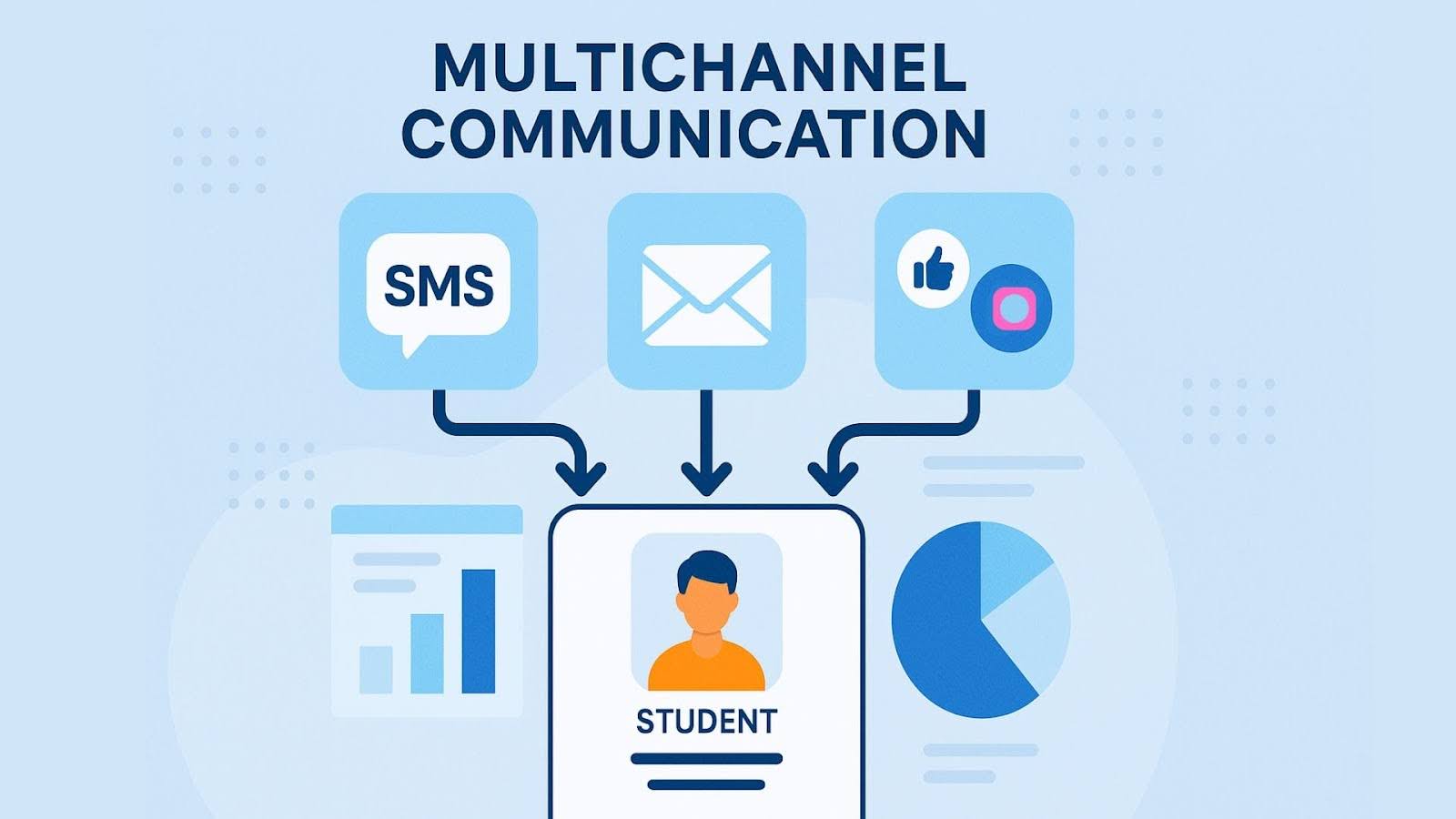Mastering Text Message Communication in Higher Ed: Tips for Effective Engagement
Communication in higher ed is undergoing a major transformation driven by rising student expectations and mobile-first behavior. According to a recent EDUCAUSE QuickPoll, 71% of institutions are already using AI-powered features within communication applications, reflecting a growing shift toward mobile-first and intelligent messaging strategies that enhance student engagement.
As institutions seek more direct and responsive ways to connect, text message communication in higher ed is a key factor in driving enrollment, engagement and academic success. Unlike phone calls or emails that may go ignored, SMS messages are opened within minutes and foster a sense of immediacy and familiarity among mobile users.
From admissions to advising and schedule changes to deadline reminders, higher education text messaging platforms are enabling institutions to communicate in a timely manner right when students need support. Leveraging text-based communication as part of your multichannel communication strategy is essential.
Why You Should Adopt Text Message Communication in Higher Ed
As students become increasingly reliant on mobile phones for daily interactions, institutions need to adapt their communication channels to meet learners where they are. Higher education SMS tools offer a direct, familiar and non-intrusive way to connect, whether to share deadline reminders, respond to inquiries or check in on student well-being. Text-based communication is reshaping how institutions foster connection and accountability across the student lifecycle.
The Shift Toward Mobile-First Engagement
More than 90% of college-age students own a smartphone, and most keep their devices within arm’s reach throughout the day. With such high mobile phone user saturation, text messaging offers an unmatched opportunity to cut through the noise. Unlike email, which can get buried, or voice calls, which are often ignored, SMS messages are short, skimmable and generally welcome, especially when they’re personalized. By recognizing this behavior, institutions can move toward more active participation and engagement.
High Open Rates and Immediate Reach: The SMS Advantage
SMS offers immediacy. Studies consistently show that text messages boast open rates of 98% or higher, often within minutes of delivery. They're ideal for schedule changes, appointment reminders and other time-sensitive updates.
For institutions juggling multiple cohorts, departments and time zones, the ability to send text messages that are received and read almost instantly is a game-changer for effective communication, especially when paired with automation and segmentation tools.

From Recruitment to Retention: The Full Lifecycle Impact
A thoughtful SMS communication strategy supports students long before they set foot on campus and long after they graduate. During recruitment, texting can be used to nudge students toward application completion or event registration.
Once enrolled, it can guide them through key milestones like class registration, advising appointments and tuition deadlines. For alumni, text messages can drive active engagement in giving campaigns or continuing education offerings. When used across the learner-to-earner journey, SMS becomes a vital tool for maintaining strong connections.
Effective Communication Starts with Strategy
Text messaging is about intention. To get the most out of SMS in higher ed, institutions must approach it as part of a multichannel communication plan that reflects student behaviors and preferences. When done right, text-based communication can reduce friction, improve response rates and support broader institutional goals like recruitment, retention and student satisfaction.
Understanding Student Preferences for the Right Medium
Mobile users value convenience and clarity. While some messages may be better suited for email or portals, many students prefer short, clear texts for urgent updates or quick reminders. The key is choosing the right medium for the message.
For example, schedule changes and deadlines are often better received via SMS, whereas more detailed info like training materials or financial aid instructions may warrant email. Mapping communications to student preferences boosts engagement and improves customer satisfaction in the long run.
Timing and Frequency: Avoiding Burnout While Staying Top of Mind
Even the best-intentioned messages can become noise if overused. To avoid this, institutions should develop a thoughtful cadence: frequent enough to stay relevant but not so much that students opt out. Consider the schedules of your audience and avoid late-night or early-morning messages unless it’s an emergency. Tools like group messaging or tagging student segments by interest can help teams send messages that are timely, relevant and well-received, fostering active engagement without overwhelming learners.
Aligning Texts with Multichannel Communication Plans
SMS should complement, not compete with, other channels. When integrated with email, CRM systems, student portals and social messaging apps, text messages can help create a seamless, two-way street of communication. Institutions that unify their communication channels see stronger student retention and more efficient staff workflows. And when every message reinforces the same theme or action item, students are far more likely to follow through, whether it's registering for a class, making a payment or attending an event.
Tips for Communicating Effectively via SMS
A well-written text message may be short, but that doesn’t mean it should be careless. In higher education SMS, tone, timing, personalization and clarity can all determine whether a student responds or ignores. These best practices will help institutions communicate effectively and meaningfully, especially when connecting with diverse audiences across programs and student interests.
Personalization and Relevance: Speak Their Language
Generic texts don’t perform well in any industry. Students are more likely to engage when they receive messages tailored to their interests, actions or milestones. Using a student’s first name, program of study or upcoming deadline in a short message service builds trust and relevance.
For example: “Hi Alex, your payment for Spring 2025 is due Friday. Visit the portal to avoid late fees.” This kind of personalized SMS usage feels supportive, not robotic and encourages active participation.
Use Cases: Group Texts, Schedule Changes and Critical Alerts
Text messaging is highly effective for group texts around course updates, weather-related schedule changes or reminders about registration windows. Instead of mass emails that go unread, institutions can send messages instantly to targeted cohorts or filtered student groups. Whether it's reminding first-years to meet with an advisor or notifying commuters about parking issues, SMS delivers information in a timely manner. The right strategy reduces confusion, supports student well-being and helps staff stay agile across departments.
Ensuring Compliance with Messaging Regulations
No text message communication in higher ed strategy is complete without proper compliance. Institutions must follow regulations such as the Telephone Consumer Protection Act (TCPA), which requires student opt-in for most text communications. Additionally, colleges must maintain written records of consent and opt-outs.
Solutions that support automated compliance checks and internal communications tracking make it easier to ensure compliance without overburdening staff. You can effectively avoid legal issues while respecting students’ privacy and communication boundaries.
Integrating SMS into Broader Marketing Campaigns
When aligned with email, social media and CRM workflows, SMS messages can significantly increase conversion rates by delivering timely nudges that reinforce your core messaging. A robust multichannel communication strategy creates a consistent, student-centered experience across all digital platforms.

Connecting SMS to Email, Social and CRM for Seamless Outreach
While email may offer more space for details and attachments, SMS thrives in the role of a real-time reminder. For instance, you can send a text message 24 hours before an event to boost attendance while using email for logistics and context days earlier.
SMS also complements social outreach by driving students from a mobile device straight to a landing page or video link. When integrated with your CRM, SMS becomes a powerful tool for automating business communications, tracking engagement and ensuring that no student slips through the cracks.
Leveraging Data to Refine Messaging and Target the Right Customer Base
One of the biggest benefits of SMS as part of a marketing campaign is tracking response times, engagement and behavioral trends. Institutions can test message timing, refine content and segment audiences by specific interests, from degree completion to workforce training. With the right analytics, you can identify what kinds of messages drive the most positive feedback and which groups are more likely to receive text messages versus emails. Over time, you can tailor outreach for each unique customer base, improving both relevance and overall success.
Common Pitfalls to Avoid in Text Communication
While SMS is one of the most effective ways to connect with students, it’s also easy to misuse. Without clear guidelines and thoughtful execution, even well-meaning messages can create friction, confusion or disengagement. To ensure your communication strategy contributes to student success, not stress, avoid these frequent missteps.
Overuse or Misuse: When Messages Become Noise
One of the most common errors is sending too many messages too often, especially without segmentation or personalization. When students are flooded with texts that don’t feel relevant, such as repeated reminders, vague calls to action or information better suited for email, they may opt out completely. In this case, the impact is the exact opposite of the intended outcome. Think quality over quantity: focus on key points, keep messages concise and always ask, “Is this best delivered via text?”
Failing to Capture Feedback or Track Engagement Metrics
Texting is a two-way street, not just a broadcast channel. Institutions that treat SMS as a one-directional alert system miss a vital opportunity for active engagement. Allow space for students to seek clarification, ask questions or respond with feedback.
Equally critical is tracking engagement, such as response rates, link clicks and opt-outs, to gauge what’s working. Without analytics, departments can’t measure their team’s progress or adapt campaigns for better results. That’s a missed opportunity for improved communication and long-term student satisfaction.

SMS as a Key Factor in Student Success and Satisfaction
Text messaging is a proven tool for improving student outcomes. When students receive clear, timely and supportive communication, they’re more likely to stay enrolled, meet deadlines and feel connected to campus life. SMS fosters academic success and reinforces the institution’s commitment to student well-being.
Real-Life Examples of SMS Improving Enrollment and Retention
At Kellogg Community College, the shift to SMS as a primary communication tool transformed the way staff engaged with students. After adopting a messaging platform, the institution launched a text-based campaign aimed at students with incomplete applications or missing documentation.
The result: Over 500 students re-engaged with 90 of them successfully enrolled in classes. By using SMS to communicate reminders, answer questions and offer guidance, Kellogg helped students overcome barriers and keep moving forward. This kind of text message communication in higher ed is truly transformative.
Text Messaging as a Student Support and Engagement Tool
Beyond enrollment and deadlines, SMS can encourage everyday connections. Quick check-ins, mental health reminders, tutoring updates or campus event invites all contribute to a more engaged, supported student experience.
When used intentionally, SMS messages create a rhythm of trust, where students know they’ll get the information they need when they need it. Building a sense of community increases active participation, especially for students juggling work, family and academics. For non-traditional learners, these nudges may be the key factor that keeps them enrolled and thriving.
Make SMS a Cornerstone of Modern Communication
Attention spans are short and inboxes are overflowing, but text message communication in higher ed offers something refreshingly simple: clarity, speed and connection. When used thoughtfully, SMS can drive student engagement, boost retention and ensure no one misses an update.
At Modern Campus, we understand how vital it is to meet students where they are. Our higher education SMS solution, Modern Campus Message, helps institutions craft meaningful, timely outreach that supports every stage of the student journey.
From improving communication efficiency to driving real results like the 500+ re-engaged students at Kellogg Community College, we’re here to help you make messaging a strategic asset, not just another channel. Let’s build stronger connections one message at a time. Want to see how text messaging can work for your institution? Connect with us to learn more.
Last updated: April 30, 2025



